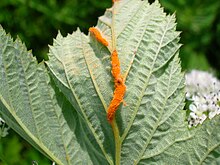
Rusts are fungal plant pathogens of the order Pucciniales causing plant fungal diseases.

Filipendula ulmaria, commonly known as meadowsweet or mead wort, is a perennial herbaceous plant in the family Rosaceae that grows in damp meadows. It is native throughout most of Europe and Western Asia. It has been introduced and naturalised in North America.
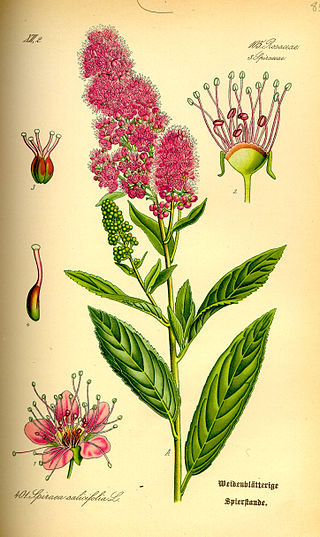
Spiraea, sometimes spelled spirea in common names, and commonly known as meadowsweets or steeplebushes, is a genus of about 80 to 100 species of shrubs in the family Rosaceae. They are native to the temperate Northern Hemisphere, with the greatest diversity in eastern Asia.

Filipendula is a genus of 12 species of perennial herbaceous flowering plants in the family Rosaceae, native to the temperate regions of the Northern Hemisphere. Well-known species include meadowsweet and dropwort, both native to Europe, and queen-of-the-forest and queen-of-the-prairie, native to North America.
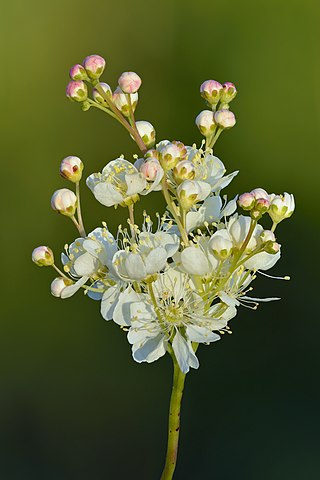
Filipendula vulgaris, commonly known as dropwort or fern-leaf dropwort, is a perennial herbaceous plant in the family Rosaceae, closely related to meadowsweet. It is found in dry pastures across much of Europe and central and northern Asia, mostly on lime.
British NVC community MG2 is one of the mesotrophic grassland communities in the British National Vegetation Classification system.
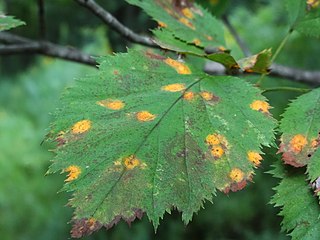
Gymnosporangium globosum is a fungal plant pathogen that causes cedar-hawthorn rust.

Gymnosporangium juniperi-virginianae is a plant pathogen that causes cedar-apple rust. In virtually any location where apples or crabapples (Malus) and Eastern red cedar coexist, cedar apple rust can be a destructive or disfiguring disease on both the apples and cedars. Apples, crabapples, and eastern red cedar are the most common hosts for this disease. Similar diseases can be found on Quince and hawthorn and many species of juniper can substitute for the eastern red cedars.

Gymnosporangium sabinae is a species of rust fungus in the subdivision Pucciniomycotina. Known as pear rust, European pear rust, or pear trellis rust, it is a heteroecious plant pathogen with Juniperus sabina as the main primary (telial) host and Pyrus communis as the main secondary (aecial) host.

Dibotryon morbosum or Apiosporina morbosa is a plant pathogen, which is the causal agent of black knot. It affects members of the Prunus genus such as; cherry, plum, apricot, and chokecherry trees in North America. The disease produces rough, black growths that encircle and kill the infested parts, and provide habitat for insects.
Meadowsweet may refer to:
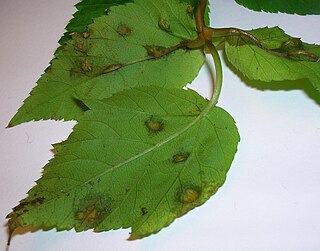
Protomyces macrosporus is an ascomycete fungus that forms galls on Aegopodium podagraria, Anthriscus sylvestris, Angelica sylvestris, Daucus carota and some other members of the family Umbelliferae or Apiaceae, commonly known as umbellifers. Fourteen genera within the Asteraceae are also galled by P. macrosporus. The description of the genus was based on Protomyces macrosporus as the type genus for the family Protomycetaceae.

Puccinia poarum, a species of fungus, known as the coltsfoot gall rust, or meadow grass rust, is a plant pathogen. This fungal parasite forms a yellow to orange gall, 1–2 cm in diameter, on the underside of leaves of coltsfoot. It also infects but does not gall grasses of the family Poaceae. P. poarum is a genetically diverse species that has been reported on at least seventy plant hosts. It was originally found on Poa fertilis and Poa nemoralis in Denmark in 1877.

Phragmidium is a genus of rust fungus that typically infects plant species in the family Rosaceae. It is characterised by having stalked teliospores borne on telia each having a row of four or more cells. All species have a caeoma which is a diffuse aecidium lacking a peridium.
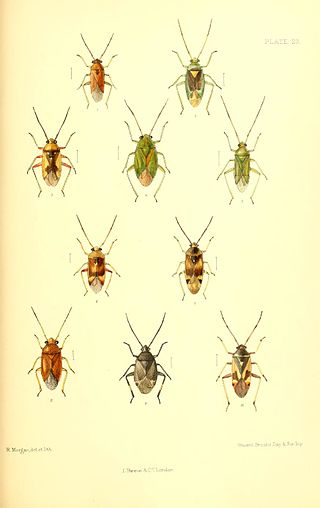
Apolygus spinolae is a species of true bug in the Miridae family. It can be found throughout Europe, except for Albania, Estonia, Liechtenstein, Malta, and Portugal. and not in the extreme south. Then east across the Palearctic to Siberia, and through Central Asia to China and Japan

Ustilago esculenta is a species of fungus in the Ustilaginaceae, a family of smut fungi. It is in the same genus as the fungi that cause corn smut, loose smut of barley, false loose smut, covered smut of barley, loose smut of oats, and other grass diseases. This species is pathogenic as well, attacking Manchurian wild rice, also known as Manchurian ricegrass, Asian wild rice, and wateroat. This grass is its only known host.

Pine-pine gall rust, also known as western gall rust, is a fungal disease of pine trees. It is caused by Endocronartium harknessii, an autoecious, endocyclic, rust fungus that grows in the vascular cambium of the host. The disease is found on pine trees with two or three needles, such as ponderosa pine, jack pine and scots pine. It is very similar to pine-oak gall rust, but its second host is another Pinus species. The fungal infection results in gall formation on branches or trunks of infected hosts. Gall formation is typically not detrimental to old trees, but has been known to kill younger, less stable saplings. Galls can vary from small growths on branch extremities to grapefruit-sized galls on trunks.
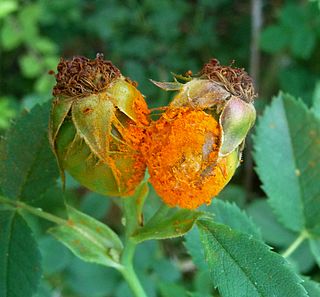
The study of gene-for-gene interactions uncovers genetic components, evolutionary impacts, and ecological/economic implications between rust fungi and plants. Rust fungi utilize the gene-for-gene interaction to invade host plants. Conversely, host plants utilize the gene-for-gene interaction to prevent invasion of rust fungi.

Ramularia ulmariae is a fungal species described by Cooke in 1876. Ramularia ulmariae belongs to the genus Ramularia and the family Mycosphaerellaceae. No subspecies are listed in the Catalog of Life.

Podosphaera filipendulae is a fungal species that belongs to the genus Podosphaera and the order Erysiphaceae. It was first described with meadowsweet as the host plant.
